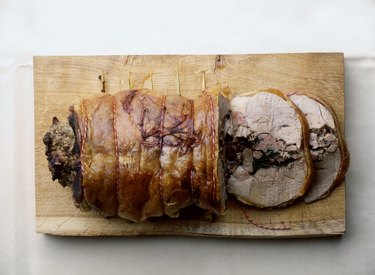
Pork tenderloin is a lean cut of pork that can dry out quickly. Foil-wrapped pork tenderloin is a great way to prepare this cut of meat to lock in flavor and moisture. Pork loin may not be as apt to dry out, but covering your pan with foil while roasting helps the meat retain its juiciness.
Pork Tenderloin Vs. Pork Loin
Video of the Day
You're not alone if you don't know the difference between pork tenderloin and pork loin. Though these cuts of meat come from the same area of the pig, they differ in size and flavor.
Video of the Day
The loin roast is found between the shoulder and leg of the pig. You can purchase pork loin roasts with or without the bone, and the cuts can weigh as much as 4 pounds. According to the National Pork Board, pork loin is best cooked on a grill or roasted in the oven. Braising or stewing pork loin causes the meat to lose its tenderness and isn't recommended.
Pork tenderloin is cut from the full pork loin and is one of the most tender, leanest cuts of pork and usually only weigh 3/4 to 1 1/2 pounds. You can grill, roast or saute your pork tenderloin. And while a 4-pound pork loin can take more than an hour to roast in the oven, you can have pork tenderloin on the table in less than 45 minutes.
If you're counting calories or fat grams, you may prefer pork tenderloin over pork loin. According to nutrition information from the USDA, a 3.5-ounce serving of roasted pork tenderloin has 143 calories, 26 grams of protein, 3.5 grams of total fat and 1.2 grams of saturated fat. The same serving of roasted pork loin has 173 calories, 27 grams of protein, 6 grams of total fat and 1.9 grams of saturated fat.
Foil-Wrapped Pork Tenderloin
Foil is a versatile kitchen tool and serves as a good cooking vessel for trapping in flavor and juices and works well with tender cuts of meat like pork tenderloin. Because pork tenderloin is so mild, it marries well with many flavors. When preparing your foil-wrapped pork tenderloin, use a pork tenderloin recipe that includes the flavors you enjoy, such as a dry rub made of citrus, garlic, onion, salt and pepper.
To make your foil-wrapped pork tenderloin, first preheat your oven to 400 degrees Fahrenheit, as recommended by the National Pork Board. Pat your pork tenderloin dry and place on a piece of foil large enough to completely surround the cut of meat. Season your meat and wrap it with foil, leaving enough space for the heat to be able to circulate around the meat.
Cook the pork tenderloin in foil in the oven for 20 to 30 minutes, or until the pork has reached an internal temperature of 145 F, as recommended by FoodSafety.gov. The foil not only protects your tenderloin, but also also helps redistribute the heat from your oven so your meat cooks more evenly, according to the European Aluminum Foil Association. Unwrap your meat, and if desired, place under the broiler and cook for one minute on each side to create a golden crust.
Pork Loin Recipe
Just as it did with the pork tenderloin, baking your boneless pork loin with foil helps lock in juices and flavor of your favorite brine, dry spice rub or barbecue sauce. However, one of the delights of roasted pork loin is the golden, caramelized crust, which may not occur if your meat is covered in foil.
To seal in juices and make a more flavorful crust, you can sear your seasoned pork loin in a hot skillet, three to four minutes per side, before transferring it to the oven for roasting. After searing the pork loin, use tongs to place the meat in the roasting pan, but instead of wrapping the meat, cover the pan with foil.
The National Pork Board recommends roasting pork loin in a preheated 375 F oven for 20 minutes per pound, which is one hour and 20 minutes for a 4-pound roast. As with the pork tenderloin, cook your pork loin until it's reached an internal temperature of 145 F.
- National Pork Board: "Pork Loin"
- National Pork Board: "Pork Tenderloin"
- USDA: "Pork Tenderloin"
- USDA: "Pork, Fresh, Loin, Tenderloin, Separable Lean Only, Cooked, Roasted"
- FoodSafety.gov: "Safe Minimum Cooking Temperature Charts"
- National Pork Board: "Cook a Pork Loin Roast"
- European Aluminum Foil Association: "BBQ Recipes with Ed van de Shootbrugge"